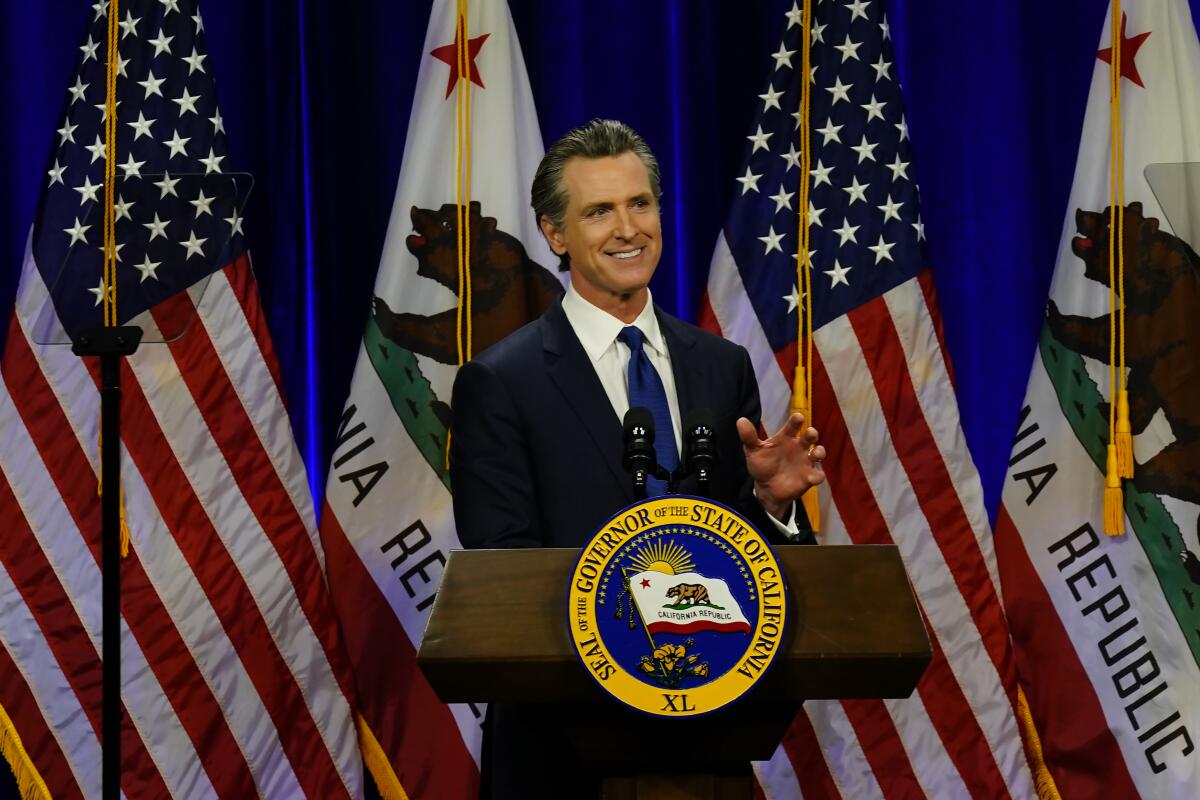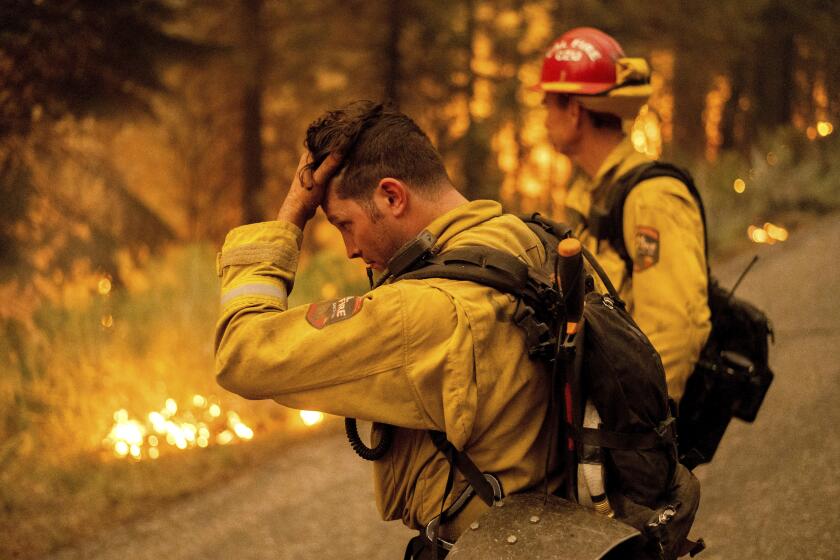Endorsement: Give Newsom a second term

- Share via
Between managing California’s response to a once-in-a-century pandemic and fighting off a recall seeking to oust him from office, Gov. Gavin Newsom has confronted extraordinary events in his first term.
Faced with these crises, Newsom rose to the occasion. He saved lives by mounting an aggressive vaccination campaign and requiring masking during the worst of the COVID-19 pandemic — and saved his career (and the state from considerable chaos) by uniting Democrats to help him resoundingly defeat last year’s petulant and risky recall effort.
Amid the tumult, Newsom advanced a progressive vision for California: More preschools and fewer prisons, more people with healthcare and fewer gas-guzzling cars. His administration has begun phasing in these important changes, but there is still a ways to go. Voters should elect Newsom to another term and hold him accountable for turning the vision into reality.
Republican state Sen. Brian Dahle from rural Lassen County and Michael Shellenberger, a Democrat turned independent from the Bay Area, are the most prominent among the two dozen challengers to Newsom in the June 7 primary. None of them appear prepared to build the coalitions necessary to mount a serious statewide campaign. Though Dahle is a thoughtful lawmaker, he’s a Trump supporter in a state that overwhelmingly opposes the former president. Shellenberger is an activist for nuclear energy and against progressive homeless policies who has never held elected office. And none of the challengers have even a fraction of Newsom’s leadership skill or record of accomplishment.
Here are the L.A. Times’ editorial board endorsements for elected offices in Los Angeles city and county, LAUSD, superior court, statewide offices, the state legislature and U.S. House and Senate seats.
Newsom should spend a second term focused on implementing his bold agenda. Preschool for all 4-year-olds will require more teachers. Healthcare for all low-income Californians, including those who are here illegally, means getting more clinics to accept the state’s Medi-Cal health insurance. Ending the sale of new gas-powered cars that are fueling the climate crisis demands a more aggressive plan to ramp up sales of zero-emissions vehicles. Closing prisons necessitates careful plans to ensure public safety. These are Newsom’s major works in progress. Their success or failure will play a big part in determining his legacy.
In other areas, Californians are already benefiting from policies Newsom enacted with the state’s booming budget: two additional weeks of paid family leave, allowing workers to take eight weeks off to bond with a new baby or care for a sick family member. Free breakfast and lunch for all public school students. More subsidized child-care slots for low-income families. Two years of tuition-free community college for full-time students. On these fronts, Newsom and the Democratic Legislature have delivered for California what Democrats have been unable to pass in Washington.
Newsom has also stumbled, of course. His administration has been painfully slow in sending out pandemic rent relief money. A wildfire prevention effort he launched more than two years ago has not completed any projects. The pace of home building in California is nowhere close to what Newsom said it should be. And, six years into cannabis legalization, which Newsom championed in 2016, the black market is still thriving. None of these are reasons to replace him. But they do point to the need for the governor to be a better manager in his next term.
Newsom deserves credit for taking steps to right some of California’s historical wrongs. He apologized to Native Americans for the state’s history of violence against Indigenous people, calling it a genocide, and has proposed giving tribes $100 million to purchase and preserve their ancestral lands. He returned shorefront property in Manhattan Beach to descendants of the Black family that owned it before it was seized by the government nearly a century ago, and launched the nation’s first effort to consider reparations for slavery — a recognition that, although California was admitted to the union as a “free state,” its early laws allowed using violence to capture enslaved people who had escaped.
Newsom’s one-time budget-surplus funding plan for climate change is a good thing. But it’s no substitute for real climate action by state lawmakers.
These are praiseworthy achievements, but voters are understandably concerned about the pinch from rising food and energy prices, the high cost of housing and the prevalence of homelessness.
Though Newsom has put more money and political capital into addressing homelessness than any modern governor, the results are often hard to see. Encampments proliferated during his time in office, a result of skyrocketing housing prices, a 2018 federal ruling that says cities can’t forbid people to sleep outside unless they have enough shelter beds to accommodate them, and then, early in the pandemic, federal guidance to leave tents in place to contain the spread of COVID-19.
We commend Newsom for using the crisis of the pandemic to come up with a new way to house many homeless people. His Project Homekey — which allows local governments to apply for funds to buy motels to transform into homeless housing — has created 44,000 new housing units for the neediest Californians. Of course, it’s hard to notice that accomplishment in a state with at least 160,000 people who lack homes.
The human misery apparent on so many streets, freeway onramps and riverbanks has created an easy target for Newsom’s political opponents. By drawing attention to the humanitarian crisis unfolding in cities and suburbs up and down the state, Newsom’s opponents are highlighting the need for California to do a better job providing mental health care and drug treatment.
These are complex parts of the homelessness problem that Newsom and lawmakers are working to resolve. If they’re successful in passing a new “CARE Court” system to compel treatment for homeless people who are addicted to drugs or have psychiatric illnesses, it will amount to another item demanding significant work to implement during Newsom’s second term.
Read more endorsements at: latimes.com/endorsements.
More to Read
A cure for the common opinion
Get thought-provoking perspectives with our weekly newsletter.
You may occasionally receive promotional content from the Los Angeles Times.











